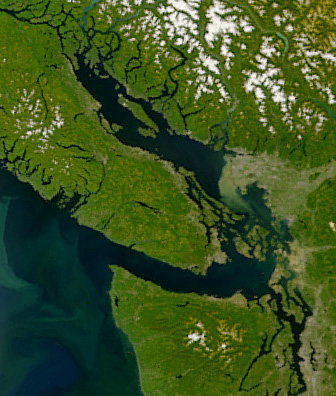http://en.wikipedia.org/wiki/Salish_Sea
The Salish Sea includes the Strait of Juan de Fuca, the Strait of Georgia, Puget Sound, and all their connecting channels and adjoining waters, such as Haro Strait, Rosario Strait, Bellingham Bay, Hood Canal, and the waters around and between the San Juan Islands in the U.S. state of Washington and the Gulf Islands in British Columbia, Canada.
Origin of the term[edit]
The first known use of the term Salish Sea was in 1988, when marine biologist Bert Webber from Bellingham, Washington, created the name for the combined waters in the region with the intention to complement the names Georgia Strait, Puget Sound, and Strait of Juan de Fuca, not replace them.[3] The adoption of the term, he said, would raise consciousness about taking care of the region's waters and ecosystems. Webber's efforts are credited with the official recognition of the term in Canada and the U.S.
Coast Salish peoples[edit]
The Coast Salish are the indigenous peoples who live in southwest British Columbia and northwest Washington state along the Salish Sea and share a common linguistic and cultural origin. The Coast Salish are seen as one of the main cultural and linguistic branches of a larger group known as Salishan or Salish. There are five recognized divisions of the Salish language family, with Coast Salish and Interior Salish being the primary two. The Salish family consists of 23 separate languages.[4] European and American explorers first encountered Salishan people along the Pacific Northwest coast in the late 18th century. The first detailed information was obtained by the Lewis and Clark Expedition of 1804-1806.[5] The term "Salish" was originally applied only to the Interior Salish Flathead tribe living in the region of Flathead Lake, Montana.[5][6] By the mid-20th century it had been extended to cover all people speaking a similar language.[7] The Flathead Nation continues to refer to their language and culture as Salish.[8][9] A variant name for Flathead Lake is "Selish Lake".[10] The name Salish Sea was coined only in the late 20th century. There is no overarching title for this area or even a commonly shared name for any of the waterbodies in any of the Coast Salish languages.
The waterways of the Salish Sea were important trade routes for the Coast Salish and they remain a source of food and other resources for the indigenous peoples. The basin includes territory of the Northern Wakashan Kwakwaka'wakw and Southern Wakashanpeoples (the Nuu-chah-nulth, Makah, and Ditidaht) and, formerly, that of the Chimakum (a Chimakuan people related to the Quileute who no longer exist as recognizable group, having been wiped out by the Suquamish and others in the 19th century).[11]

No comments:
Post a Comment